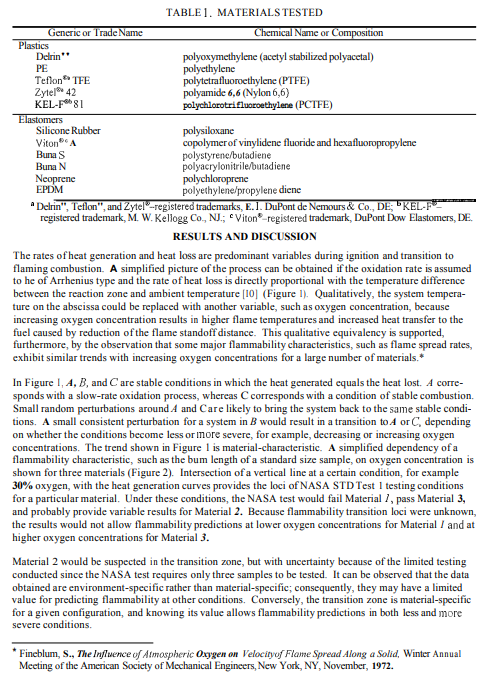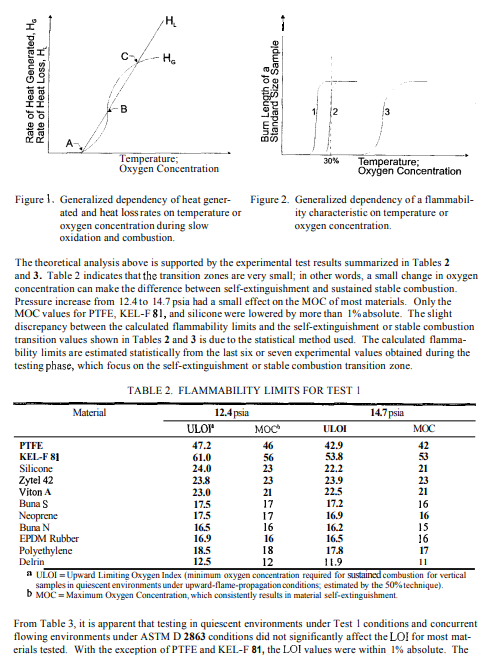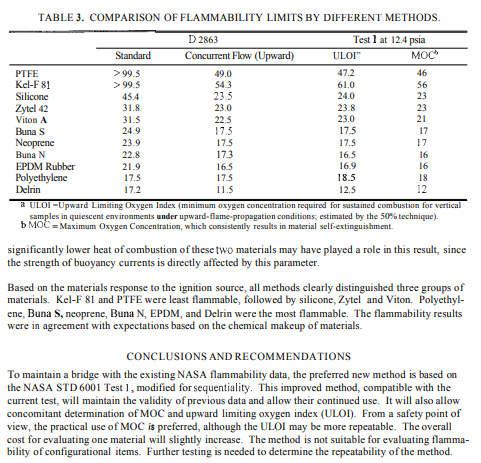Qualitative correlations between ground upward flammability tests and flammability testing in microgravity indicate that NASA STD 6001 Test 1 provides conservative results by sustaining flaming combustion in less severe environments than those in which extinguishment occurs in quiescent microgravity environments. The upward flammability test is conducted in the most severe flaming combustion environment expected in the spacecraft. Its passifail test logic does not allow a precise quantitative comparison with other ground or microgravity materials flammability test results. Thus, although reasonable from a flammability safety point of view, the test is likely to eliminate materials that may be safe for use on spacecraft. A different test logic is suggested to address these impediments: one to determine materials self-extingnishment limits. Data to support this approach are presented, including self-extinguishment limits in concurrent and countercurrent flows and under quiescent conditions. The proposed method will allow continued use of existing NASA flammability data and make possible quantitative correlations between ground testing and microgravity test results. These correlations will improve the aerospace materials selection process and allow realistic estimates of spacecraft fire extinguishment requirements. Theoretical analyses of flaming combustion will also be possible, leading to a better understanding of materials combustion. This will benefit not only the aerospace community but also the combustion community at large.
Spacecraft tire safety emphasizes fire prevention, which is achieved primarily through the use of fireresistant materials. Materials selection for spacecraft is based on conventional flammability acceptance tests, along with prescribed quantity limitations and configuration control for items that are nonpass or questionable [I]. NASA STD 6001 Test 1 [2] is the major method used to evaluate flammability of materials intended for use in the habitable environments of US spacecraft. The method is an upward flame-propagation test in a quiescent environment using a well-defined igniter flame at the bottom of a vertically mounted sample. A material passes this test if the vertical bum length is less than 15.2 cm and there is no evidence oftransfer of burning debris [2]. The upward flammability test is conducted in the most severe flaming combustion environment expected in the spacecraft. Test 1 provides conservative results by sustaining materials flaming combustion in less severe environments than those in which extinguishment occurs in quiescent microgravity environments [3]. For many years this test method has provided data that have allowed the US to achieve an outstanding spacecraft fire safety record.
Although reasonable from a flammability safety point of view, NASA STD 6001 Test 1 has a few drawbacks.The test may eliminate materials that may be safe for use on spacecraft. On the positive side, it is conservative, but it may be overly conservative on occasion. Its degree of conservativeness varies for different materials and cannot be estimated from the data, since it is impossible to estimate how far a material is removed from the combustion threshold conditions. The Test I pass/fail test logic does not allow a precise quantitative comparison with other ground or microgravity materials flammability test results; therefore its use is limited, and possibilities for an in-depth theoretical analysis and realistic estimates of spacecraft fire extinguishment requirements are practically eliminated. Attempts for precise quantitative correlations between results provided by Test 1 and other ground flammability tests generally have encountered little success. Previously, a version of NASA STD 6001 Test 1 was compared with Critical Oxygen Index test results conducted with a method similar to ASTM G 125* [4]. The data indicated that if a material had a critical oxygen index of at least 35, it could be used in the Spacelab environ-ment containing 23.8% oxygen. The empirical correlation determined, based on these tests, has been later shown not to always hold [5]. The difficulty of quantifying NASA STD 600 results has been revealed in a study [6] that attempted to correlate its results with Heat Release Rate Tests, conducted according to ASTM E 1354* and the Lateral Ignition and Flame Spread Tests (LIFT), conducted per ASTM E 1321.t This study deduced that the mean upward spread velocities in the NASA tests appear to correlate inversely with the minimum heat flux for opposed flow spread and the minimum heat flux for ignition in the LIFT tests. Furthermore, the study indicates that the peak heat release determined by cone calorimetry would not predict flammability performance in the NASA test [6]. A different result was reported for three composites in a study where the upward flame spread rate and flame spread length were shown to increase with the peak heat release rate [7].
A different test logic is suggested to address the NASA STD Test 1 test logic impediments: one that can determine materials self-extinguishment limits. Data to support this approach are presented, including materials self-extinguishment limits under concurrent and countercurrent flowing conditions and under quiescent conditions. The new test logic will preserve the merits of the existing method by maintaining the validity of previous data and allowing its continued use.
MATERIALS:
The materials evaluated are described in Table 1. Samples tested in flowing environments were 5. I cm wide by 10.2 cm long, while samples tested in quiescent environments were 6.4 cm wide by 15.2 cm long. The difference in sample dimensions was due to the different sample holder configurations. All samples had a thickness of approximately 1.5 mm.
TEST SYSTEMS:
The tests in flowing environments were conducted using a Stanton Redcroft Model FTA-I Oxygen Index apparatus. The test system met the requirements of ASTM D 2863.i The apparatus was connected to gaseous nitrogen and oxygen supplies. Before entering the glass column, the test environment was mixed and analyzed for oxygen content with a paramagnetic oxygen analyzer. Tests in quiescent environments were conducted in a 1400-L flammability chamber connected to a vacuum pump with air, oxygen, and nitrogen supplies. The test system met the NASA STD 6001 Test 1 requirements.
PROCEDURES:
Limiting oxygen index (LOI) testing procedures in flowing environments are described in ASTM
D 2863. The downward flame propagation tests were standard. Upward flame propagation tests were conducted on vertical samples ignited at the bottom. Flammability transition testing in quiescent environments was conducted following NASA STD 6001 Test 1 procedures. The testing was conducted sequentially as recommended by ASTM D 2863, and using a step size of 1% oxygen. The upward LOIS were calculated with the “up-and-down method for small samples’’ [8]. This method has been adopted by both IS0 4589 [9] and ASTM D 2863 for determining the “minimum oxygen concentration required to support combustion of plastics.” The maximum oxygen concentration that consistently results in self-extinguishment (MOC) was the oxygen concentration at which self-extinguishment consistently occurred in
the LO1 vicinity.


